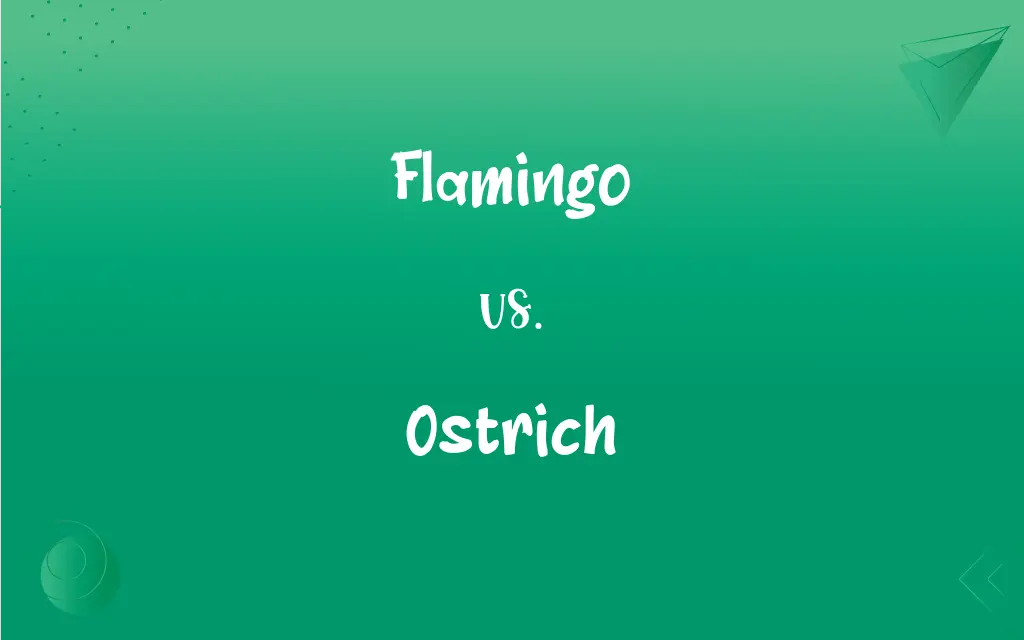Flamingo vs. Ostrich: What's the Difference?
By Aimie Carlson & Harlon Moss || Updated on March 4, 2024
Flamingos are colorful, water-loving birds known for their long legs and pink feathers, while ostriches are the largest and heaviest land birds, famous for their speed and inability to fly.

Key Differences
Flamingos are iconic for their vibrant pink to red plumage, a coloration derived from their diet rich in beta-carotene. They are found in warm, watery regions where they feed on shrimp, algae, and other small organisms. Ostriches, on the other hand, are native to Africa and are distinguished by their impressive size, long necks, and strong legs. They are flightless but can run at speeds up to 45 miles per hour, making them the fastest birds on land.
Flamingos are social birds that live in large colonies, which can include thousands of individuals. These colonies help protect against predators and increase the efficiency of finding food. Ostriches also live in groups, but their social structure is typically smaller and can vary from pairs to flocks of a few dozen. They use their excellent vision and speed to avoid predators.
Flamingos lay a single egg on a mud mound they build, while ostriches lay their eggs in communal nests that can contain several dozen eggs, overseen by a dominant female and male.
The diet of flamingos primarily consists of aquatic organisms, which they filter from the water with their specialized beaks. Ostriches are omnivores, eating a variety of plants, seeds, insects, and small vertebrates.
Comparison Chart
Size
Medium-sized birds, up to 4-5 feet tall.
The largest birds, up to 9 feet tall.
ADVERTISEMENT
Habitat
Warm, watery environments across the globe.
Dry savannas and open woodlands of Africa.
Color
Pink to red feathers, due to diet.
Mostly brown and black feathers for camouflage.
Diet
Aquatic organisms, like shrimp and algae.
Omnivorous, including plants, seeds, and insects.
Social Structure
Large colonies.
Small groups or flocks.
Reproduction
One egg per season, on a mud mound.
Communal nests with several dozen eggs.
ADVERTISEMENT
Flight
Capable of flying.
Flightless.
Flamingo and Ostrich Definitions
Flamingo
Birds that live in large colonies and feed on shrimp and algae.
We saw a colony of flamingos feeding at sunset.
Ostrich
Ostriches lay the largest eggs of any land animal.
We visited a farm where ostrich eggs were being incubated.
Flamingo
A type of wading bird known for its distinctive pink feathers.
The flamingo stood on one leg in the shallow water.
Ostrich
The world's largest bird, native to Africa, known for being flightless.
The ostrich ran across the savanna at incredible speeds.
Flamingo
They have long legs and necks, adapted to their aquatic environment.
The flamingo's long neck is perfect for reaching food in the water.
Ostrich
Either of two large, swift-running flightless birds (Struthio camelus or S. molybdophanes) of Africa, characterized by a long bare neck, small head, and two-toed feet. Ostriches are the largest living birds.
Flamingo
Any of several large wading birds of the family Phoenicopteridae, primarily of tropical regions, having reddish or pinkish plumage, long legs, a long flexible neck, and a bill turned downward at the tip.
Ostrich
A rhea.
Flamingo
A moderate reddish orange.
Ostrich
One who tries to avoid disagreeable situations by refusing to face them.
Flamingo
A wading bird of the family Phoenicopteridae.
Ostrich
(ornithology) A large flightless bird of the genus Struthio.
Flamingo
A deep pink color tinged with orange, like that of a flamingo.
Ostrich
The most widespread species of the genus, known as the common ostrich (Struthio camelus).
Flamingo
Of a deep pink color tinged with orange, like that of a flamingo.
Ostrich
(figurative) One who buries one's head in the sand instead of acknowledging problems.
Flamingo
Any bird of the genus Phœnicopterus. The flamingoes have webbed feet, very long legs, and a beak bent down as if broken. Their color is usually red or pink. The American flamingo is P. ruber; the European is P. antiquorum.
Ostrich
(golf) The hypothetical completion of a hole five strokes under par (a quintuple birdie, quadruple eagle, triple albatross, or double condor).
Flamingo
Large pink to scarlet web-footed wading bird with down-bent bill; inhabits brackish lakes
Ostrich
A large bird of the genus Struthio, of which Struthio camelus of Africa is the best known species. It has long and very strong legs, adapted for rapid running; only two toes; a long neck, nearly bare of feathers; and short wings incapable of flight. The adult male is about eight feet high.
Ostrich
A person who refuses to face reality or recognize the truth (a reference to the popular notion that the ostrich hides from danger by burying its head in the sand)
Ostrich
Fast-running African flightless bird with two-toed feet; largest living bird
Ostrich
They have a long neck and legs, and can run faster than any other bird.
Ostriches use their powerful legs to escape predators.
FAQs
Can flamingos live in cold environments?
While flamingos prefer warm climates, some species can tolerate cold temperatures and live in high-altitude or temperate regions.
Why can't ostriches fly?
Ostriches cannot fly because their large body size and wing structure are not suited for flight; instead, they have evolved to be excellent runners.
Are ostriches social animals?
Yes, ostriches are somewhat social, living in groups that help them look out for predators.
What predators do ostriches have?
Ostriches face predators such as lions, cheetahs, and hyenas in the wild, but their speed and size can deter many potential threats.
How fast can an ostrich run?
An ostrich can run at speeds up to 45 miles per hour, making it the fastest bird on land.
Do flamingos migrate?
Yes, some species of flamingos migrate to find food and suitable breeding sites, traveling hundreds of miles.
How do flamingos get their pink color?
Flamingos obtain their pink color from their diet, which is rich in beta-carotene found in organisms like shrimp and algae.
How long do flamingos live?
Flamingos can live for 20 to 30 years in the wild and even longer in captivity, with some records of up to 50 years.
What is the significance of flamingos standing on one leg?
Flamingos may stand on one leg to conserve body heat and maintain balance while resting, although the exact reason is still studied.
What is the largest egg an ostrich can lay?
Ostrich eggs are the largest of any living land animal, weighing about 3 pounds and measuring up to 6 inches in length.
How do ostriches defend themselves from predators?
Besides running, ostriches can defend themselves with powerful kicks, capable of injuring or even killing predators.
How do flamingos and ostriches differ in their nesting habits?
Flamingos build individual mud mound nests for their single egg, while ostriches lay their eggs in large communal nests on the ground, shared by several females.
How effective are flamingos in flight?
Despite being better known for their time in the water, flamingos are quite effective flyers, capable of traveling long distances at high speeds to migrate or find food.
What adaptations do ostriches have for living in hot environments?
Ostriches have several adaptations for hot climates, including long legs for dissipating heat, sparse feathering on their bodies to avoid overheating, and behavioral adaptations like panting and using their wings to shade their legs.
How do flamingos mate and raise their young?
Flamingos engage in synchronized group mating dances to choose their partners. Both parents then take turns incubating the egg and feeding the chick.
What is the diet of an ostrich?
Ostriches are omnivores, consuming a variety of vegetation, seeds, insects, and occasionally small vertebrates, adapting their diet to the availability of resources.
Why do ostriches have such large eyes?
Ostriches have large eyes to enhance their vision, crucial for spotting predators from a distance across the open savannas where they live.
Can ostriches swim?
Ostriches can swim if needed, but they rarely encounter situations that require them to do so, given their arid and semi-arid habitats.
What role do flamingos play in their ecosystem?
Flamingos contribute to their ecosystem by filtering water as they feed, controlling populations of aquatic organisms, and serving as indicators of environmental health.
What is the social structure of a flamingo colony?
Flamingo colonies are highly social and structured, involving complex interactions for mating, feeding, and predator avoidance, with strong bonds formed within the group.
About Author
Written by
Aimie CarlsonAimie Carlson, holding a master's degree in English literature, is a fervent English language enthusiast. She lends her writing talents to Difference Wiki, a prominent website that specializes in comparisons, offering readers insightful analyses that both captivate and inform.
Co-written by
Harlon MossHarlon is a seasoned quality moderator and accomplished content writer for Difference Wiki. An alumnus of the prestigious University of California, he earned his degree in Computer Science. Leveraging his academic background, Harlon brings a meticulous and informed perspective to his work, ensuring content accuracy and excellence.































































